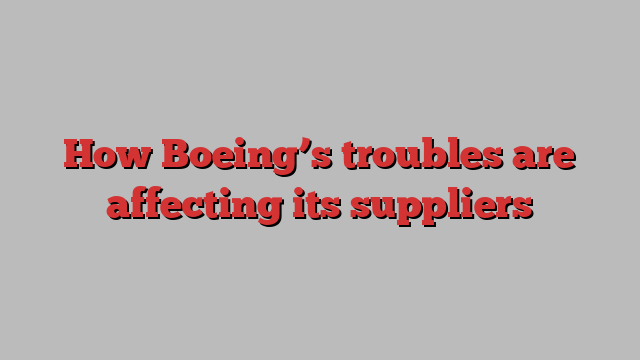
How Boeing’s troubles are affecting its suppliers
Boeing’s troubles are bleeding out to its supply chain, where uncertainty over production rates has suppliers guessing at how many parts to make to avoid the cost of holding too much stock.
The aircraft maker has slowed manufacturing of its workhorse jet, the 737 Max, as it tries to improve production quality following a door panel blowout on a flight in January. It is facing a Thursday deadline from federal aviation regulators to deliver a plan that addresses what a panel of aviation experts described as a flawed safety culture.
The production slowdown is testing the resilience of a brittle aerospace supply chain that already has faced years of price cuts and choppy production thanks to Covid-19 and two fatal crashes that grounded the Max worldwide.
Without a well-oiled supply chain, Boeing will struggle to deliver jets to airlines clamouring for them, and could destabilise labour in an industry that employs hundreds of thousands of workers.
Production rates were “the elephant in the room”, Boeing supplier Astronics chief executive Peter Gundermann told investors earlier this month. Headquartered in upstate New York, the electric power systems maker said it could lose $11.5mn in revenue if its shipments were cut, although earnings will still fall within the company’s guidance.
Each 737 Max contained about $95,000 in Astronics products, Gundermann said. “Will they slow down suppliers?” he asked. “They might, it’s unclear . . . What would they reschedule us to? I mean it’s kind of a wild guess at this point, nobody really knows.”
The Federal Aviation Administration has capped Boeing’s production of the Max at 38 per month. Boeing is building fewer than that but plans to raise output to 38 in the second half of the year. Chief financial officer Brian West has said the company is adjusting the schedules that govern the pace and volume at which it buys parts, from landing gear to lavatories.
That affects the operations and finances for suppliers, some of which are public companies with market capitalisations in the billions. The ones that do a lot of business with Boeing were “feeling the pain at the moment”, said one industry consultant.
“Everybody was expecting a ramp-up in the production of the 737 and 787,” he said. “They may have invested in people or capacity to meet that ramp- up, and when they get pushed back, it’s a problem.”
The supply chain already had been “severely weakened” over the past decade, said Kevin Michaels, managing director of Aerodynamic Advisory. Former Boeing CEO Jim McNerney began an initiative in 2012 that continued under Dennis Muilenburg where the manufacturer insisted on price cuts and extending payment terms.
“If you’ve set up rules where your supply chain can’t function, you can’t get a return on capital, then that means that you’re probably going to play Whac-A-Mole when you try to ramp up to a higher rate,” he said.
Spirit, which has had its own struggles with quality, has been the most high-profile casualty of the slowdown on the Max. Boeing stopped accepting Max fuselages from the Kansas manufacturer that do not meet specifications in an effort to reduce “travelled work” at its own factory in Renton, Washington, where work performed out of sequence increases the likelihood of manufacturing errors.
Though the two companies reached a deal in April for Boeing to pay Spirit $425mn, the supplier still reported a first-quarter operating cash outflow of $416mn, a $617mn net loss and increased inventory. It said on May 16 it would lay off about 450 workers.
Joe Buccino, a Spirit spokesman, said the company would “always adjust to the delivery rate of our customer”.
In a statement, Boeing spokesman Paul Lewis said: “We continue to work closely with each of our suppliers as we manage and execute our production rate plans.”
But Spirit is far from alone. Howmet Aerospace, Triumph Group, Hexcel, Senior and ATI all have been affected by the slowdown on the 737, though some have offset it with other work, such as overhauling geared turbofan engines or securing more defence work where demand is booming.
Triumph chief executive Daniel Crowley said last week that for fiscal year 2025, ending March 31, the company assumed its rate to deliver products to Boeing would slow 20-30 per cent, depending on the programme and component. Triumph expects $1.2bn in sales for the fiscal year — about $70mn less than its earlier internal assumption.
Triumph supplies about $300,000 worth of equipment on each Max, including systems to extend and retract landing gear and the gearbox for the engine. It supplies about $1mn worth on the 787.
“We’ve adopted conservative assumptions,” Crowley said. “And we don’t expect to have to come back to investors and analysts and say, ‘Hey, it’s actually worse, and we’ve got a hole in our forecast’.”
The company also has slowed ordering materials from its own suppliers, which it increased last year in anticipation of increased production rates.
The slowdown at Boeing caused the company to “completely replan” its year, Howmet chief executive John Plant said earlier this month. Howmet is now assuming Boeing will produce 20 Maxes a month for the rest of the year, down from a previous assumption of 34. With its fastener business, Howmet is planning to deliver lower volumes “to prevent the case where we get caught with a lot of . . . inventory”.
The strains in the supply chain have rippled through to Boeing’s main rival, Airbus, which is boosting production to meet surging demand from airline customers and needs its suppliers to keep pace. But suppliers often service Boeing and Airbus, making it difficult to assume additional fixed costs, such as more staff, when the plane makers’ production rates diverge. High interest rates have only increased the cost pressures.
The supply chain was stressed, Airbus chief executive Guillaume Faury told investors in April, and “we see this knock-on effect”.






